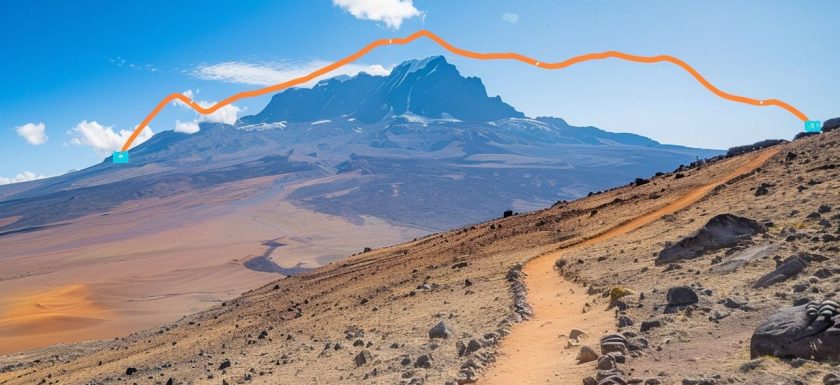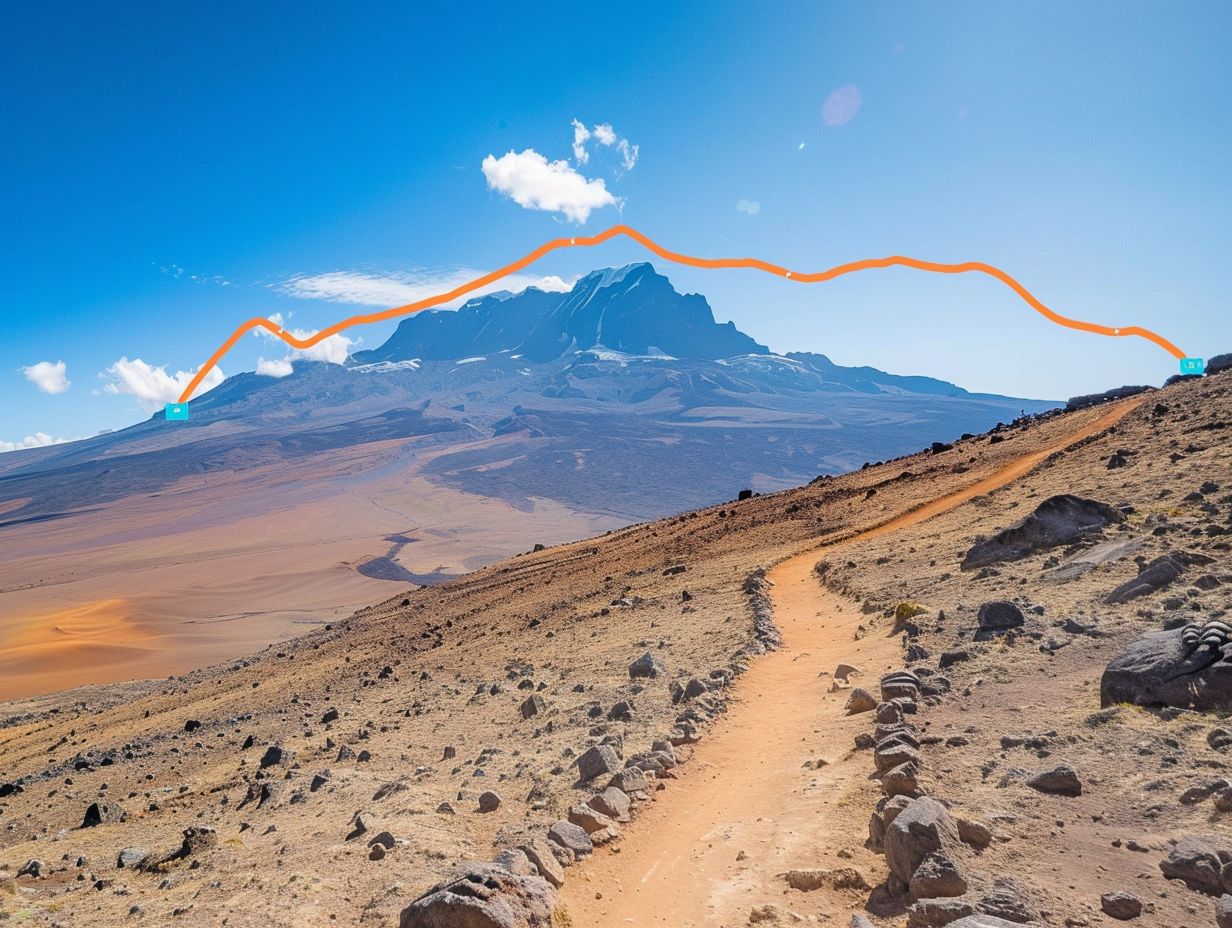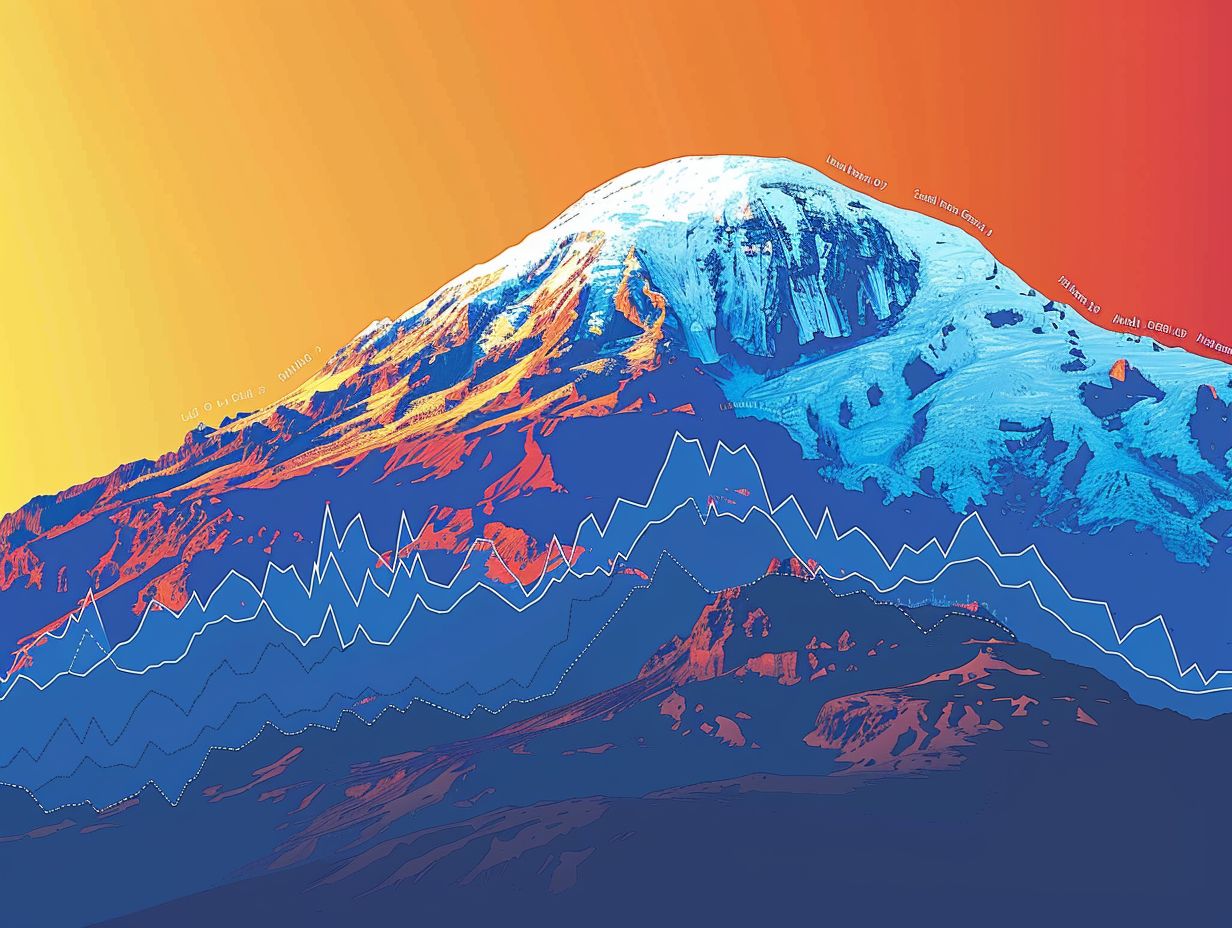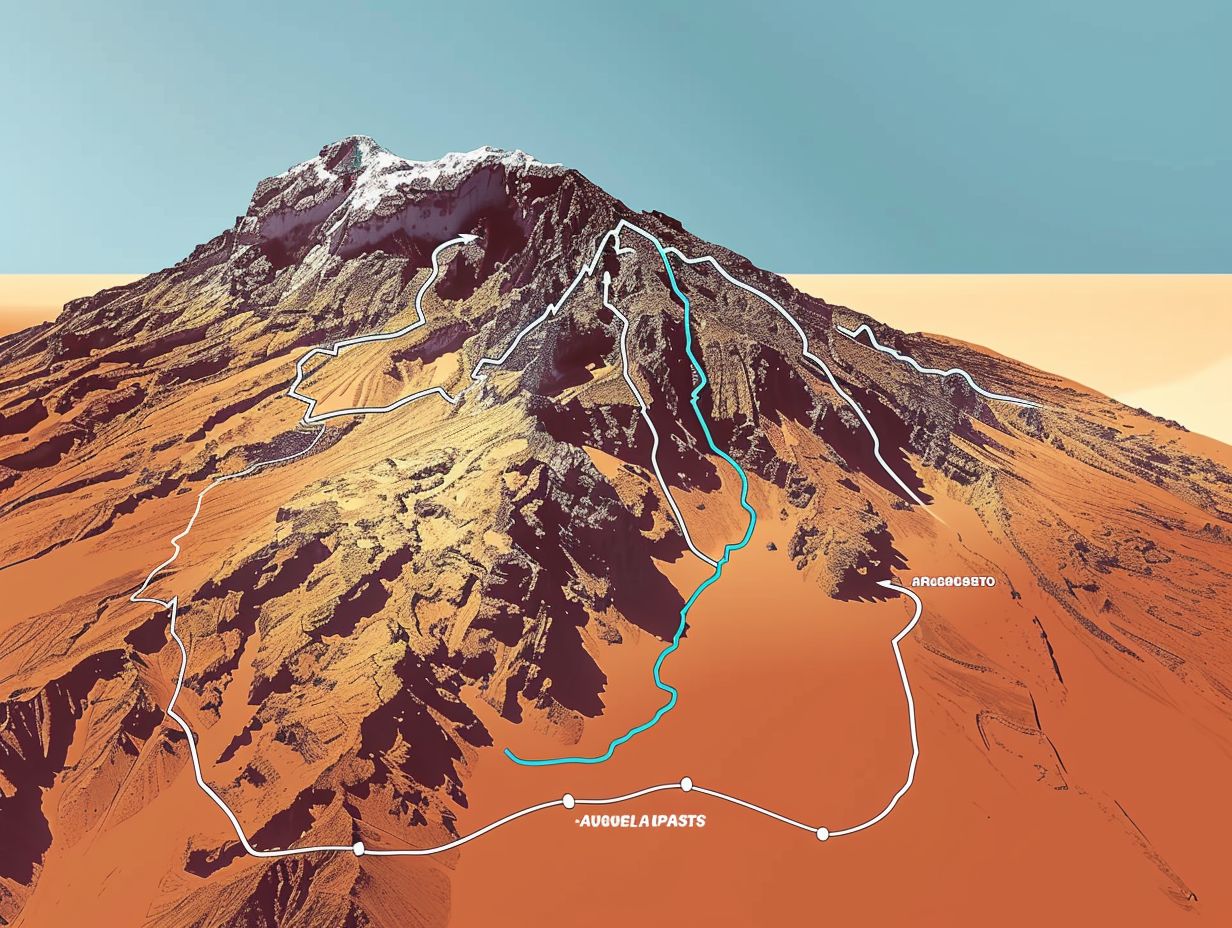
Are you dreaming of conquering the majestic Kilimanjaro?
Before you lace up your hiking boots, it’s essential to understand the different routes available and their success rates.
From the popular Marangu Route to the challenging Umbwe Route, each path offers a unique adventure.
In this article, we will explore the success rates of each route, factors that can affect your climb, and provide tips on choosing the right route for your Kilimanjaro expedition.
So, grab a cup of coffee and let’s dive into the world of mountain trekking!
Key Takeaways:

- The Machame Route has the highest success rate among the five Kilimanjaro routes, with an average of 85-90%.
- The success rate on Kilimanjaro is greatly influenced by factors such as altitude sickness, fitness level, weather conditions, and the quality of guides and support teams.
- When choosing a route, it is important to consider your own fitness level and acclimatization abilities to increase your chances of success.
What Are the Success Rates of Each Route?
Understanding the success rates of the different routes on Kilimanjaro is crucial for climbers to choose the most suitable path based on their preferences, experience, and objectives.
When considering climbing this iconic peak, the Marangu Route, also known as the ‘Coca-Cola’ route, stands out for its higher success rates primarily due to its gradual ascent providing more time for acclimatization compared to other options.
On the other hand, the Machame Route, known as the ‘Whiskey’ route, is favored for its diverse landscapes and offers a more challenging but rewarding climb.
The Lemosho Route boasts excellent summit success rates and a scenic approach through varied terrain.
Rongai Route, starting from the northern side, provides a quieter hiking experience with greater chances of wildlife encounters.
Conversely, the Umbwe Route, known for its steep and direct climb, is considered one of the most challenging routes due to rapid altitude gain, thus demanding climbers with high fitness levels.
Marangu Route Success Rate
The Marangu Route boasts a moderate success rate due to its more gradual ascent profile and hut accommodations that provide a comfortable resting environment for climbers, contributing to their acclimatization and overall performance.
One of the key factors influencing climbers’ success on the Marangu Route is the gradual ascent profile it offers. Unlike some other more challenging routes, the Marangu Route provides a more manageable climb, allowing climbers to acclimatize more effectively.
The availability of hut accommodations along the way plays a significant role in ensuring climbers have a comfortable place to rest and recover, which is crucial for maintaining their physical and mental well-being during the trek.
The structured nature of the route, with designated stopping points and established facilities, aids in climbers’ acclimatization process. By allowing for gradual adjustments to the altitude, climbers are better positioned to avoid altitude-related illnesses and perform better overall.
Expert guidance from experienced guides familiar with the route can also greatly enhance climbers’ chances of success by offering valuable insights, support, and safety measures throughout the journey.
Machame Route Success Rate
The Machame Route’s success rate is influenced by its challenging terrain and varying altitudes, requiring climbers to adhere to a structured acclimatization profile and potentially seek expert guidance for a successful summit attempt.
Acclimatization is one of the key factors determining whether climbers reach the summit of Mount Kilimanjaro via the Machame Route. The route’s rapid ascent profile demands careful adaptation to altitude to prevent altitude sickness and ensure overall well-being throughout the climb.
Expert guidance plays a vital role in helping climbers navigate the technical sections of the route and make informed decisions regarding pacing and rest periods. Professional support can be invaluable in managing energy levels, hydration, and nutrition effectively.
Physical preparedness is paramount for tackling the demanding sections of the trail, including the Barranco Wall and the steep ascent to Barafu Camp. Climbers must prioritize strength training, cardiovascular conditioning, and endurance building to increase their chances of a successful summit bid.
Lemosho Route Success Rate
The Lemosho Route has garnered a favorable success rate among climbers, attributed to its longer duration that allows for better acclimatization, stunning landscapes, and lower congestion compared to other routes.
These factors play a crucial role in increasing the chances of climbers reaching the summit successfully. Many climbers have shared positive experiences, emphasizing the gradual altitude gain and diverse scenery as highlights of their journey on the Lemosho Route.
Statistical data shows a consistent trend of higher summit success rates for climbers who opt for this route over others, showcasing its reputation as a preferred choice for those seeking a rewarding Kilimanjaro experience.
Rongai Route Success Rate
The Rongai Route showcases a commendable success rate, benefiting from its less crowded trails, tranquil wilderness setting, and strategic operator support that enhances climbers’ chances of reaching the summit successfully.
Operators play a crucial role in shaping the success rates on the Rongai Route. They provide essential guidance, expertise, and logistical support to climbers, ensuring a safe and efficient ascent. The personalized attention and care offered by experienced operators can significantly boost climbers’ morale and performance throughout the journey.
The route’s varying landscapes, from lush forests to alpine deserts, offer a diverse and captivating experience for climbers, making the ascent not just a physical challenge but also a visually stunning adventure.
Umbwe Route Success Rate

The Umbwe Route presents a challenging yet rewarding journey with a success rate influenced by climbers’ preparedness, quality of guiding services, and essential equipment provisions necessary for navigating the steep and demanding terrain.
Guides play a crucial role in ensuring climbers are well-versed with the route’s intricacies and equipped to tackle its hurdles.
Determination is paramount for reaching the summit, as mental resilience often determines success more than physical prowess.
Proper gear, including sturdy boots, warm clothing, and sufficient food and water, is non-negotiable.
- Challenges on the Umbwe Route include steep inclines, unpredictable weather, and high altitude effects.
- Strategies involve gradual acclimatization, pacing oneself, and following the guide’s instructions meticulously.
Factors That Affect Success Rates on Kilimanjaro
Several key factors play a pivotal role in determining the success rates of climbers attempting to conquer Kilimanjaro. These factors encompass altitude sickness, fitness levels, weather conditions, and the expertise of guides and support teams.
Altitude, being one of the most formidable challenges, can lead to altitude sickness, affecting climbers’ well-being and performance. The higher you ascend, the more crucial it becomes to acclimatize properly to prevent adverse effects.
Fitness levels are equally significant, as the demanding terrain and long hours of trekking necessitate a strong physical condition.
Weather preparedness is essential on Kilimanjaro, where conditions can change rapidly, from scorching sun to chilling winds and even snow. The guidance provided by experienced guides and reliable support teams can make a profound difference in ensuring climbers stay safe and motivated throughout their ascent.
Altitude Sickness
Altitude sickness poses a significant challenge for climbers scaling Kilimanjaro, with symptoms ranging from mild discomfort to severe complications due to the body’s struggle to acclimatize to higher elevations.
The physiology of altitude sickness stems from the decrease in oxygen levels at higher altitudes, leading to reduced oxygen saturation in the bloodstream. This lack of oxygen can trigger a cascade of symptoms, including headaches, nausea, fatigue, and shortness of breath.
Individuals with pre-existing health conditions such as heart or lung issues are at higher risk for developing severe forms of altitude sickness. It is crucial for climbers to acclimate slowly, staying hydrated, and avoiding rapid ascents to minimize the risk of developing altitude sickness.
Fitness Level
Physical fitness plays a vital role in determining climbers’ ability to conquer Kilimanjaro, requiring endurance, strength, and cardiovascular fitness to withstand the rigors of high-altitude trekking and challenging terrain.
A successful ascent of Kilimanjaro demands a high level of overall fitness and stamina. Climbers must be prepared to endure long hours of walking each day, carrying a heavy pack, and navigating steep inclines.
Endurance is crucial for sustained performance at high altitudes where oxygen levels are lower. Additionally, strength training is essential to support the body during extended periods of exertion. Cardiovascular fitness is necessary for efficient oxygen utilization which aids in acclimatization. Proper training techniques, such as interval training and elevation gain exercises, can significantly enhance a climber’s readiness for the demanding Kilimanjaro expedition.
Weather Conditions
Weather conditions on Kilimanjaro can vary dramatically, posing challenges such as sudden temperature changes, precipitation, and high winds that impact climbers’ comfort, safety, and overall acclimatization process.
Proper clothing is essential to combat these varying conditions, including layering for temperature fluctuations and waterproof gear for unexpected rain or snow. Climbers must carefully time their ascent to avoid extreme weather events, aiming for the dry seasons between January-March and June-October.
Acclimatisations is crucial, with gradual altitude adjustments helping climbers cope with the reduced oxygen levels and harsh weather conditions at higher elevations. Being prepared for the diverse weather patterns ensures a safer and more enjoyable climbing experience on Kilimanjaro.
Guide and Support Team
The expertise of guides and the support provided by trekking operators play a crucial role in climbers’ success on Kilimanjaro, offering essential navigation, safety, and logistical assistance throughout the journey.
Experienced guides are not only knowledgeable about the various routes up the mountain, but they are also adept at managing emergency situations and ensuring climbers follow proper safety protocols. Without their guidance, climbers may face increased risks and challenges navigating the treacherous terrain.
A reliable support team helps boost climbers’ motivation and mental resilience, providing encouragement, assistance with equipment, and logistical support that eases the physical demands of the climb. This combination of expertise and support significantly enhances climbers’ chances of reaching the summit successfully.
Tips for Choosing the Right Route for You

Selecting the most suitable route for your Kilimanjaro ascent requires careful consideration of factors such as trekking duration, acclimatization needs, official success rates, and personal preferences to ensure a fulfilling and successful climbing experience.
When deciding on a route, it’s crucial to assess your own physical fitness and experience level. Some routes are more technically challenging than others, while some are known for their scenic beauty.
- Considering the trekking duration is essential, as longer routes provide better acclimatization opportunities, reducing the risk of altitude-related illnesses.
- Looking into official success rates can give you an idea of the popularity and safety of a specific route. Routes with higher success rates typically have better infrastructure and support services.
Consulting with experienced guides or tour operators is highly recommended, as they can provide valuable insights based on current conditions and individual requirements. Choosing the right route is not only about reaching the summit but also about enjoying the journey and ensuring a memorable experience.
Conclusion: Which Kilimanjaro Route Has the Highest Success Rate?
Determining the Kilimanjaro route with the highest success rate involves analyzing various factors such as climber experience, acclimatization preferences, and expert guidance to identify the most optimal path for achieving summit success.
One crucial aspect to consider when selecting the best route is the level of difficulty and altitude gain along the path. Routes like the Machame and Lemosho are favored by climbers for their better acclimatization opportunities, increasing the chances of reaching the summit. Expert guides often recommend routes with longer durations to allow for gradual altitude adjustment and reduce the risk of altitude sickness, enhancing safety and success rates.
Frequently Asked Questions
What are Kilimanjaro route success rates?
Kilimanjaro route success rates refer to the percentage of climbers who successfully reach the summit of Mount Kilimanjaro via a specific route. It is an important factor to consider when choosing a route for your climb.
Which Kilimanjaro route has the highest success rate?
The Marangu route is considered to have the highest success rate, with an average of 85% of climbers reaching the summit. This is due to its gradual ascent and shorter duration.
What is the success rate for the Machame route?
The Machame route has a success rate of around 75%, making it the second-highest success rate among all the routes. However, this route is more physically demanding and requires a longer acclimatization period.
Is the success rate for the Lemosho route lower than other routes?
The Lemosho route has a success rate of approximately 70%, which is slightly lower than the Marangu and Machame routes. However, this route offers stunning views and a more remote experience.
Why do some routes have higher success rates than others?
The success rates of Kilimanjaro routes depend on various factors such as the length and difficulty of the route, the acclimatization period, and the number of climbers on the route. Routes with longer durations and better acclimatization tend to have higher success rates.
Can I improve my chances of success by choosing a route with a higher success rate?
While choosing a route with a higher success rate may increase your chances of reaching the summit, it is not a guarantee. It is important to choose a route that suits your physical ability and allows for proper acclimatization for a safe and successful climb.